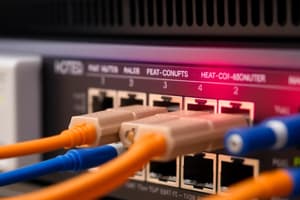Podcast
Questions and Answers
What is the primary function of a router?
What is the primary function of a router?
To determine the best path to forward packets and to forward packets toward their destination.
What is the longest match in routing?
What is the longest match in routing?
The route in the routing table that has the greatest number of far-left matching bits with the destination IP address.
The default route is sometimes referred to as a __________.
The default route is sometimes referred to as a __________.
gateway of last resort
Which of the following is NOT a mechanism for packet forwarding?
Which of the following is NOT a mechanism for packet forwarding?
A packet will be dropped if there is no match in the routing table and no default route is available.
A packet will be dropped if there is no match in the routing table and no default route is available.
What must a router do before forwarding a packet to a destination device?
What must a router do before forwarding a packet to a destination device?
What command is used to begin enabling IPv6 on a router?
What command is used to begin enabling IPv6 on a router?
The packet forwarding function is primarily responsible for __________ packets in the appropriate data link frame type.
The packet forwarding function is primarily responsible for __________ packets in the appropriate data link frame type.
Which of the following commands is used to verify a router’s configured interfaces?
Which of the following commands is used to verify a router’s configured interfaces?
A routing table contains a list of routes to known networks identified by ______.
A routing table contains a list of routes to known networks identified by ______.
Which of the following routing sources indicates a directly connected network?
Which of the following routing sources indicates a directly connected network?
Which code indicates a static route in the routing table?
Which code indicates a static route in the routing table?
What does the 'O' code represent in a routing table?
What does the 'O' code represent in a routing table?
The default route has an IPv4 route entry of ______.
The default route has an IPv4 route entry of ______.
A directly connected route must have at least one active interface configured with an IP address.
A directly connected route must have at least one active interface configured with an IP address.
Which code represents a route that is a candidate for a default route?
Which code represents a route that is a candidate for a default route?
What must be present in a routing table entry for a specific network address?
What must be present in a routing table entry for a specific network address?
Which routing protocol is mentioned as being used for dynamic route learning?
Which routing protocol is mentioned as being used for dynamic route learning?
Which of these routing protocols are classified as Interior Gateway Protocols (IGPs)? (Select all that apply)
Which of these routing protocols are classified as Interior Gateway Protocols (IGPs)? (Select all that apply)
Administrative distance represents the ______ of the route.
Administrative distance represents the ______ of the route.
Static routes are commonly used for networks requiring automatic adaptation to topology changes.
Static routes are commonly used for networks requiring automatic adaptation to topology changes.
What is the primary purpose of dynamic routing protocols?
What is the primary purpose of dynamic routing protocols?
The best path to a network is the path with the lowest __________.
The best path to a network is the path with the lowest __________.
Match the routing protocols with their metrics:
Match the routing protocols with their metrics:
What does the term 'longest match' refer to in routing?
What does the term 'longest match' refer to in routing?
Only EIGRP supports unequal cost load balancing.
Only EIGRP supports unequal cost load balancing.
What does BGP stand for?
What does BGP stand for?
Static routes are commonly used as a default route forwarding packets to a __________.
Static routes are commonly used as a default route forwarding packets to a __________.
Flashcards are hidden until you start studying
Study Notes
Routing Concepts Overview
- Routers determine forwarding paths based on packet information and their routing table.
- Key router functions include routing decision-making and actual packet forwarding to destinations.
Path Determination
- Routing involves deciding which interface a packet should take to reach its destination.
- Routers maintain an IP routing table to identify the best forwarding paths.
Best Path Criteria
- The best path is determined by the "longest match" principle.
- Longest match refers to the highest number of far-left bits in the destination IP address that match an entry in the routing table.
- Routing entries consist of a prefix (network address) and a prefix length that guide this matching process.
Routing Table Composition
- Directly Connected Networks: Automatically added to the routing table when interfaces are configured and active.
- Remote Networks: Learned either through static routes (manually configured) or dynamic routing protocols (automatically learned).
- Default Route: Acts as a catch-all. It is used when no specific route matches, with a /0 prefix length indicating that any destination could be matched.
Packet Forwarding
- Packet forwarding consists of several key steps once the best path is determined:
- The router checks the destination IP in the packet header and consults the routing table.
- It finds the longest matching prefix and then encapsulates the packet in the appropriate data link frame.
- If no matching route exists, the packet is dropped.
Forwarding Scenarios
- Directly Connected Network: If the destination IP is part of a directly connected network, the packet is sent directly to the device.
- Next-Hop Router: If the destination is remote, the packet is forwarded to a next-hop router, requiring the MAC address of that router.
- Dropping Packets: Packets with no available routes are simply discarded.
Packet Forwarding Mechanisms
- Different packet forwarding methods influence performance:
- Process Switching: An older mechanism where the CPU matches the destination address for every packet, slower due to processing overhead.
- Fast Switching: Uses a cache for quicker forwarding based on previous next-hop information, improving efficiency after the first packet.
- Cisco Express Forwarding (CEF): The default mechanism that uses a Forwarding Information Base (FIB) and adjacency tables, optimizing packet switching significantly.
Basic Router Configuration Review
- Configuration commands are crucial for setting up routers, including interface descriptions, IP and IPv6 addresses, and enabling interfaces.
- Ensure access security with console and line passwords, and enable routing.
Verification Commands
- Command examples include:
show ip interface briefshow running-config interfaceping
- Use of
|pipe character to filter command outputs allows for more specific data retrieval.
IP Routing Table Structure
- Routing tables consist of routes from:
- Directly connected networks.
- Static routes.
- Dynamic routing protocols.
- Each entry includes a source code indicating how the route was learned, facilitating network management and troubleshooting.### Common Route Codes
- L: Identifies the local address assigned to a router interface.
- C: Denotes a directly connected network.
- S: Represents a static route for a specific network.
- O: Indicates a dynamically learned network via OSPF protocol.
- *: Marks a candidate for a default route.
IP Routing Table Principles
- Each router independently decides routing based on its own table, without knowledge of others' routes.
- Routing information for a path does not guarantee return routing for packets from the destination back to the source.
IP Routing Table Entries
- Route Source: Indicates how the route was learned.
- Destination Network: Specifies the address of the remote network along with the prefix length.
- Administrative Distance (AD): Measures the trustworthiness of the route source; lower values suggest higher trust.
- Metric: Represents the cost to reach a network; lower is preferred.
- Next-Hop: IP address of the subsequent router for packet forwarding.
- Exit Interface: Egress interface used to send packets to their destinations.
Directly Connected Networks
- A router learns about remote networks only if it has an active interface configured with an IP address.
- Directly connected networks get a status code of C; local routes for activated interfaces are indicated by L.
- Local routes have a prefix length of /32 for IPv4 and /128 for IPv6.
Static Routes
- Manually configured routes providing explicit paths between devices.
- Essential for ease of maintenance in smaller networks.
- Used for default routes to direct traffic to unknown destinations.
Dynamic Routing Protocols
- Enable routers to automatically share information on network reachability and status.
- OSPF is an example used to learn network routes automatically.
Default Routes
- Serve as a next-hop when no specific route matches a destination IP.
- Represented as 0.0.0.0/0 for IPv4 or ::/0 for IPv6.
Structure of IPv4 Routing Table
- Organized based on obsolete classful addressing.
- Indented entries (child routes) show subnets of classful addresses.
Structure of IPv6 Routing Table
- Lacks classful addressing; all entries are uniformly formatted.
- Simple and direct representation of routing information without indents.
Administrative Distance
- Determines which routing source to trust; lower distance equals higher trustworthiness.
- Routing protocol associated AD values include:
- Directly Connected: 0
- Static Route: 1
- OSPF: 110
- RIP: 120
Static vs Dynamic Routing
- Static Routing:
- Used for smaller networks, specific routing paths, and for links needing control.
- Requires manual configuration, providing inherent security.
- Dynamic Routing:
- Ideal for larger networks, automatically adapting to topology changes.
- Scalable and efficient for growing networks.
Dynamic Routing Features
- Configuration complexity varies; dynamic routing simplifies management as network size increases.
- Resource usage is higher for dynamic protocols due to CPU, memory, and bandwidth requirements.
- Path predictability is determined by the routing protocol in use, while static routing paths are defined by administrators.
Historical Context
- Dynamic routing protocols have been used since the late 1980s, with RIP being one of the earliest examples.### Routing Protocols Overview
- RIPv1 introduced in 1988; basic algorithms date back to ARPANET in 1969.
- Routing protocols evolve as networks grow in complexity.
- Classification of routing protocols includes Interior Gateway Protocols (IGPs) and Exterior Gateway Protocols (EGPs).
Interior and Exterior Gateway Protocols
- IGPs exchange information within a single organization's domain.
- BGP is the sole EGP, facilitating routing between different autonomous systems (AS).
- Types of IGPs include Distance Vector (e.g., RIPv2, EIGRP) and Link-State (e.g., OSPF, IS-IS).
- BGP versions for IPv4 and IPv6 are BGP-4 and BGP-MP, respectively.
Functions of Dynamic Routing Protocols
- Dynamic routing protocols help discover remote networks and maintain current routing information.
- They select optimal paths and adapt to changes by identifying new best paths as needed.
Key Components of Dynamic Routing Protocols
- Data Structures: Use tables or databases stored in RAM for routing information.
- Routing Protocol Messages: Various types exchange routing data and maintain network accuracy.
- Algorithms: Finite step lists that assist in routing information processing and determining best paths.
Best Path Selection
- The best path is determined using metrics, a quantitative measure of network distance.
- Common dynamic protocols:
- RIP: Metric based on hop count (max 15 hops).
- OSPF: Metric based on cumulative bandwidth (lower costs for faster links).
- EIGRP: Factors in bandwidth, delay, load, and reliability.
Load Balancing
- Equal Cost Load Balancing: Router utilizes multiple paths of equal cost concurrently, enhancing network performance.
- Only EIGRP supports Unequal Cost Load Balancing.
Routing Decision Mechanism
- Routers forward packets based on routing table information, seeking the longest match with destination IP addresses.
- Decisions rely on directly connected networks, static routes, and dynamic protocols.
- Packet forwarding methods include process switching, fast switching, and Cisco Express Forwarding (CEF).
Routing Table Structure
- IPv4 tables structured using classful addressing; IPv6 tables differ significantly.
- Administrative Distance (AD) indicates route trustworthiness; lower AD signifies higher reliability.
Configuration and Verification
- Essential commands:
show ip route,show ip interface,show ip interface brief, andshow running-config. - Default routes are utilized when specific routes cannot be matched in the routing table, can be static or dynamically learned.
Summary of Dynamic Routing Protocols
- Designed for scalability in complex networks.
- Adapt automatically to changes in network topologies.
- Fundamental for maintaining efficient routing operations.
Studying That Suits You
Use AI to generate personalized quizzes and flashcards to suit your learning preferences.




